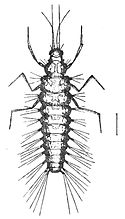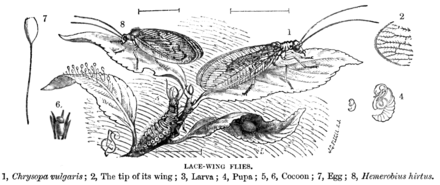Neuroptera
| Neuroptera Temporal range: Permian to recent
| |
|---|---|

| |
Green lacewing
| |
| Scientific classification | |
| Domain: | Eukaryota |
| Kingdom: | Animalia |
| Phylum: | Arthropoda |
| Class: | Insecta |
| Clade: | Neuropterida |
| Order: | Neuroptera Linnaeus, 1758 |
| clades | |
|
See Taxonomy | |
The
Adult neuropterans have four membranous wings, all about the same size, with many
Neuropterans first appeared during the
Anatomy and biology
Neuropterans are soft-bodied insects with relatively few specialized features. They have large lateral
They have four wings, usually similar in size and shape, and a generalised pattern of veins.[4] Some neuropterans have specialised sense organs in their wings, or have bristles or other structures to link their wings together during flight.[5]
The larvae are specialised predators, with elongated mandibles adapted for piercing and sucking. The larval body form varies between different families, depending on the nature of their prey. In general, however, they have three pairs of thoracic legs, each ending in two claws. The abdomen often has adhesive discs on the last two segments.[5]
Life cycle and ecology
 |
 |
The larvae of most families are
Larvae in various families cover themselves in debris (including other insects, living and dead
As in other holometabolic orders, the pupal stage is enclosed in some form of cocoon composed of silk and soil or other debris. The pupa eventually cuts its way out of the cocoon with its mandibles, and may even move about for a short while before undergoing the moult to the adult form.[5]
Adults of many groups are also predatory, but some do not feed, or consume only nectar.
Beetles, wasps, and some lake flies parasitize neuropteran larvae.

Evolution

Neuropterans first appeared near the end of the
The osmylids are of
Ithonidae are from the Jurassic to Recent, and the extinct lineages of the family were widespread geographically.[14]
Phylogeny
Molecular analysis in 2018 using mitochondrial rRNA and mitogenomic data places the Megaloptera as sister to Neuroptera, and Raphidioptera as sister to this combined lineage, though these results were considered tentative.[15][9] The fossil record has contributed to the understanding of the group's phylogeny.[1][16][17][18] Relationships within the Myrmeleontiformia are still in flux.[19]
A phylogenomic analysis published in 2023 confirmed the topology of the neuropterid orders and found the relationships between the families of Neuropterida as shown in the following phylogenetic tree.[20]
| Neuropterida |
| |||||||||||||||||||||||||||||||||||||||||||||||||||||||||||||||||||||||||||||||||||||||||||||||||||||||||||||||
Taxonomy
Review of the Neropterid group orders by Engel, Winterton, and Breitkreuz (2018) included grouping of the Neuropteran families in a nested set of clades, an abandonment of the paraphyletic suborder "Hemerobiiformia" and redefinition of Myrmeleontiformia as a clade.[21]
Neuroptera
- Superfamily Coniopterygoidea
- family Coniopterygidae dustywings (Late Jurassic-Present)
- Clade Euneuroptera
- Superfamily Osmyloidea
- Family Osmylidae: osmylids (Early Jurassic-Present)
- Family Sisyridae: spongillaflies (Late Cretaceous-Present)
- Family Nevrorthidae [Note 1] (Late Cretaceous-Present)
- Family †Archeosmylidae (Permian-Triassic)
- Family †Saucrosmylidae (Middle Jurassic)
- Superfamily Dilaroidea
- Family Dilaridae: pleasing lacewings (Late Cretaceous-Present)
- Superfamily Mantispoidea
- Family Berothidae: beaded lacewings (Late Jurassic-Present)
- Family Mantispidae: mantidflies (including †Dipteromantispidae) (Jurassic-Present)
- Family †Mesoberothidae (including †Mesithonidae) (Triassic)
- Family Rhachiberothidae: thorny lacewings (Early Cretaceous-Recent)
- Clade Neoneuroptera
- Superfamily Hemerobioidea (inc. Chrysopoidea)
- Family †Ascalochrysidae
- Family Chrysopidae: green lacewings (including †Mesochrysopidae)
- Family Hemerobiidae: brown lacewings
- Family †Osmylitidae
- Family †Solenoptilidae
- Clade Geoneuroptera
- Superfamily Ithonioidea
- Family Ithonidae: moth lacewings (includes Rapismatidae and Polystoechotidae)
- Clade Myrmeleontiformia
- Superfamily Myrmeleontoidea (syn Nemopteroidea[22])
- Family Ascalaphidae: owlflies
- Family †Babinskaiidae
- Family Myrmeleontidae: antlions (includes Palaeoleontidae)
- Family Nemopteridae: spoonwings etc
- Family Nymphidae: split-footed lacewings (includes Myiodactylidae)
- Family †Rafaelianidae
- Family
- Superfamily Psychopsoidea
- Family †Aetheogrammatidae
- Family †Kalligrammatidae
- Family †syn†Brongniartiellidae)
- Family †Panfiloviidae (syn †Grammosmylidae)
- Family †Prohemerobiidae
- Family Psychopsidae: silky lacewings
- Superfamily Myrmeleontoidea (syn Nemopteroidea[22])
- Superfamily
- Superfamily
- Superfamily Osmyloidea
The fossil genus †Mesohemerobius Ping, 1928 from the Late Jurassic-Early Cretaceous of China has been treated as incertae sedis within Neuroptera, while the fossil families †Permoberothidae and †Permithonidae are treated as a sister group to clade Eidoneuroptera formed by Neuroptera + Megaloptera.[21]
In human culture
The use of Neuroptera in
Five species of Neuroptera are among 1681 insect species eaten by humans worldwide.[24]
The New Guinea Highland people claim to be able to maintain a muscular build and great stamina despite their low protein intake as a result of eating insects including Neuroptera.[25]
Notes
References
- ^ ISBN 0-521-82149-5.
- ^ a b A. G. Ponomarenko & D. E. Shcherbakov (2004). "New lacewings (Neuroptera) from the terminal Permian and basal Triassic of Siberia" (PDF). Paleontological Journal. 38 (S2): S197–S203.
- S2CID 86240200.
- S2CID 55878344.
- ^ ISBN 0-19-510033-6.)
{{cite book}}: CS1 maint: multiple names: authors list (link - )
- ISSN 1989-953X.
- ^ Powell, Erin. (2023). Defensive behaviors of the mealybug Nipaecoccus nipae (Maskell, 1893) (Hemiptera: Pseudococcidae) and the green lacewing Ceraeochrysa claveri (Navás, 1911) (Neuroptera: Chrysopidae), with videos of dorsal packet loading and mealybug ostiole function. Insecta Mundi. 1–11.
- ^ PMID 25170303.)
{{cite journal}}: CS1 maint: multiple names: authors list (link - ^ Engel, Michael S.; Grimaldi, David A. (2007). "The neuropterid fauna of Dominican and Mexican amber (Neuropterida, Megaloptera, Neuroptera)" (PDF). American Museum Novitates (3587): 1–58.
- .
- PMID 24912379.
- .
- S2CID 55970660. Retrieved January 27, 2010.
- PMID 29381758.
- ^ Grimaldi, D. A. & Engel, M. S., 2005: Evolution of the Insects. Cambridge University Press, 2005, pages xv-755
- ^ Engel, M. S. & Grimaldi, D. A., 2007: The neuropterid fauna of Dominican and Mexican amber (Neuropterida: Megaloptera, Neuroptera). American Museum Novitates: #3587, pages 1-58
- ^ Parker, S. P. (ed.), 1982: Synopsis and classification of living organisms. Vols. 1 & 2. McGrew-Hill Book Company
- ^ Jones, J.R. (2019) Total‐evidence phylogeny of the owlflies (Neuroptera, Ascalaphidae) supports a new higher‐level classification. Zoologica Scripta: 06 October 2019 https://doi.org/10.1111/zsc.12382
- S2CID 257245897.
- ^ PMID 29324039.
- ^ Engel, M. S.; Grimaldi, D. A. (2008). "Diverse Neuropterida in Cretaceous amber, with particular reference to the paleofauna of Myanmar (Insecta)". Nova Supplementa Entomologica. 20: 1–86.
- S2CID 46558266.
- )
- ^ MacClancy, Jeremy (2007). Consuming the Inedible: Neglected Dimensions of Food Choice. Berghahn.
External links
- Oswald, John D. (2023). Neuropterida Species of the World. Lacewing Digital Library, Research Publication No. 1. (an online catalog that includes data on the Neuroptera species of the world)
- Oswald, John D. (2023). Bibliography of the Neuropterida. Lacewing Digital Library, Research Publication No. 2. (an online bibliography that includes data on the global scientific literature of the order Neuroptera)
- Lacewing Digital Library (a web portal that provides access to a suite of online resources that contain data on the order Neuroptera)
- Illustrated database of Neuroptera (insects)
- Brown lacewings of Florida on the University of Florida / Institute of Food and Agricultural Sciences Featured Creatures
- Information on Neuroptera (subscription required) at Web of Science









